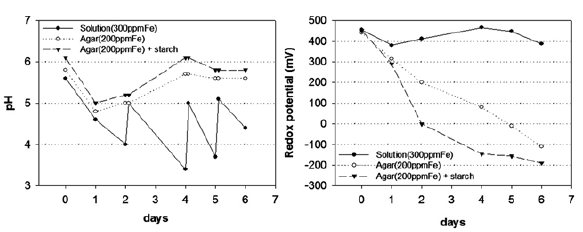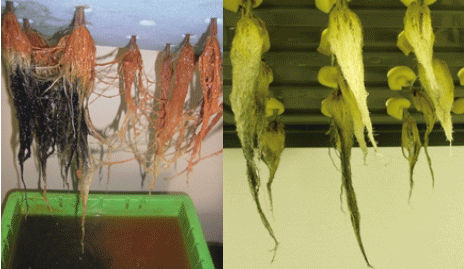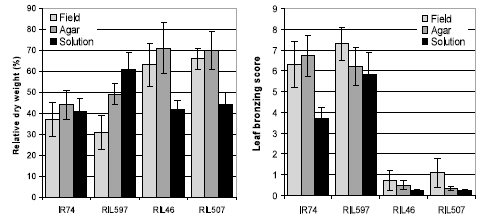A screening method using lowconcentration agar-based nutrient solutions to study zinc deficiency and iron toxicity in rice
Description
Nutrient solutions are not ideal for studying nutrient-related stresses such as iron (Fe) toxicity or zinc (Zn) deficiency, since rhizosphere changes induced by plants are not maintained in fluids, pH fluctuates rapidly, and nutrients such as Fe and P easily precipitate in solutions, particularly if excess concentrations of one nutrient are supplied to simulate stress (e.g., Fe toxicity). Furthermore, low redox potentials that are a crucial part of the mineral stresses in paddy soils are difficult to induce and maintain in solutions. A modified screening method is therefore needed that overcomes the limitations of nutrient solutions. Our objective was to test the effect of adding agar at low concentrations (0.1%) to nutrient solutions on the response of rice genotypes to Fe toxicity and Zn deficiency.
Plants developed normally in the agar control treatment (Yoshida nutrient solution in 0.1% agar; no additional stress factor added) but total dry weight was lower by about 20% relative to the control in Yoshida solution without agar. The agar system offered several advantages over conventional nutrient solutions when nutrient stresses were induced by adding 200 ppm Fe2+ (Fe toxicity) or reducing Zn concentrations to 1 nM (Zn deficiency):
- Fe precipitates remained suspended in agar and therefore stayed in the root zone. As a result, a lower concentration of Fe2+ (200 ppm Fe2+ as FeSO4 in agar, compared to 300 ppm in nutrient solution) was sufficient to induce symptoms of Fe toxicity in intolerant genotypes.
- Changes in pH are more gradual in agar and did not reach a toxic low level as they do in solutions (Fig. 1). The pH in the nutrient solution (with 300 ppm Fe2+) fell rapidly and reached levels where the pH needed to be adjusted (see increase at days 2, 4, 5). Not having to adjust pH in agar was beneficial, since the root zone remained undisturbed.
- Redox potentials decreased rapidly in agar due to low O2 diffusion and reached negative values (-Eh) after 5-6 days (Fig. 1). Very low redox potentials can be induced by addition of organic substances (starch, organic acids, etc.), presumably because their degradation causes further O2 depletion.
- Distinct microenvironments could develop around roots of different genotypes because substances excreted by roots (H+, O2, organic acids) do not rapidly move away from the root zone (Fig. 2).
- Genotypic differences become more pronounced than in nutrient solutions, and tolerance rankings of genotypes are similar in agar and in the field (Fig. 3), whereas they may differ substantially between in the field and conventional nutrient solutions.
Conclusion: It is possible to use the lowconcentration agar nutrient solution technique to screen rice genotypes for tolerance to Zn deficiency and Fe toxicity. This method is now used as a standard tool in our experiments to elucidate the genetic and physiological basis of tolerance to Zn deficiency in rice.
Figure, table
-
Fig. 1.
Changes in pH and Eh over time. -
Fig. 2.
Highly reduced conditions develop in agar, and distinct microenvironments could be observed in the rhizosphere of different genotypes. a) In susceptible genotype IR64 (left), prolonged exposure to excess Fe2+ damages roots (note black color) while the tolerant genotype IR 24637 maintains healthy roots (right). b) Genotypes tolerant to Zn deficiency showed a redox potential of -50 mV around their healthy (white) roots while roots of intolerant genotypes were already damaged (black roots) and showed an Eh of -150 mV. -
Fig. 3.
The agar method shows clear differences between susceptible genotypes (IR74 and RIL597) and tolerant genotypes (RIL 46 and RIL 507) in relative dry weight under Zn deficiency and Zn deficiency-induced leaf bronzing.
- Affiliation
-
Japan International Research Center for Agricultural Sciences Crop Production and Environment Division
- Classification
-
Technical A
- Term of research
-
FY2006(FY2006~2010)
- Responsible researcher
-
WISSUWA Matthias ( Crop Production and Environment Division )
WANG Yunxia ( Crop Production and Environment Division )
- ほか
- Publication, etc.
-
Wissuwa, M, U Hausermann, RK Singh and AM Ismail (2006) Genotypic differences for tolerance to iron toxicity in rice. 13th international symposium on iron nutrition and interactions in plants. p. 124.
- Japanese PDF
-
2006_seikajouhou_A4_ja_Part6.pdf758.22 KB



